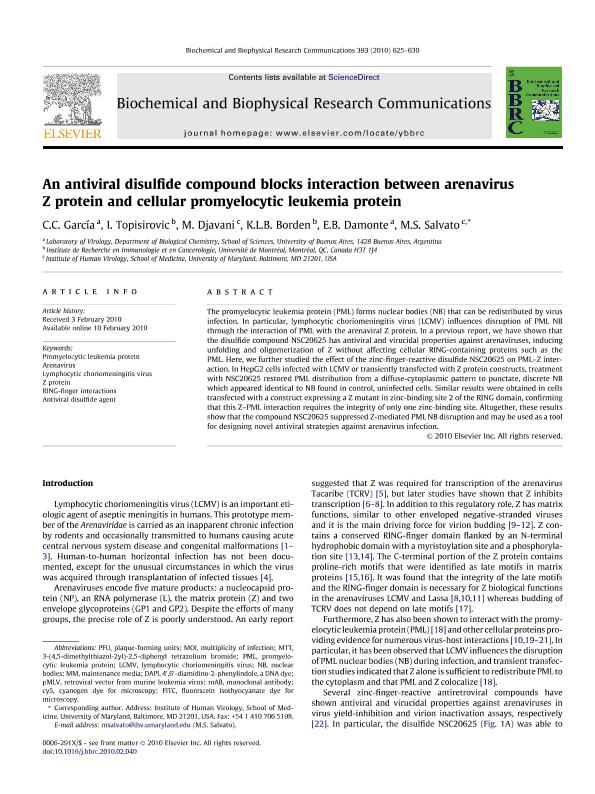Mostrar el registro sencillo del ítem
dc.contributor.author
Garcia, Cybele

dc.contributor.author
Topisirovic, I.
dc.contributor.author
Djavani, M.
dc.contributor.author
Borden, K. L. B.
dc.contributor.author
Damonte, Elsa Beatriz

dc.contributor.author
Salvato, M. S.
dc.date.available
2018-12-12T20:30:45Z
dc.date.issued
2010-03
dc.identifier.citation
Garcia, Cybele; Topisirovic, I.; Djavani, M.; Borden, K. L. B.; Damonte, Elsa Beatriz; et al.; An antiviral disulfide compound blocks interaction between arenavirus Z protein and cellular promyelocytic leukemia protein; Academic Press Inc Elsevier Science; Biochemical and Biophysical Research Communications; 393; 4; 3-2010; 625-630
dc.identifier.issn
0006-291X
dc.identifier.uri
http://hdl.handle.net/11336/66380
dc.description.abstract
The promyelocytic leukemia protein (PML) forms nuclear bodies (NB) that can be redistributed by virus infection. In particular, lymphocytic choriomeningitis virus (LCMV) influences disruption of PML NB through the interaction of PML with the arenaviral Z protein. In a previous report, we have shown that the disulfide compound NSC20625 has antiviral and virucidal properties against arenaviruses, inducing unfolding and oligomerization of Z without affecting cellular RING-containing proteins such as the PML. Here, we further studied the effect of the zinc-finger-reactive disulfide NSC20625 on PML-Z interaction. In HepG2 cells infected with LCMV or transiently transfected with Z protein constructs, treatment with NSC20625 restored PML distribution from a diffuse-cytoplasmic pattern to punctate, discrete NB which appeared identical to NB found in control, uninfected cells. Similar results were obtained in cells transfected with a construct expressing a Z mutant in zinc-binding site 2 of the RING domain, confirming that this Z-PML interaction requires the integrity of only one zinc-binding site. Altogether, these results show that the compound NSC20625 suppressed Z-mediated PML NB disruption and may be used as a tool for designing novel antiviral strategies against arenavirus infection. © 2010 Elsevier Inc. All rights reserved.
dc.format
application/pdf
dc.language.iso
eng
dc.publisher
Academic Press Inc Elsevier Science

dc.rights
info:eu-repo/semantics/openAccess
dc.rights.uri
https://creativecommons.org/licenses/by-nc-sa/2.5/ar/
dc.subject
Antiviral Disulfide Agent
dc.subject
Arenavirus
dc.subject
Lymphocytic Choriomeningitis Virus
dc.subject
Promyelocytic Leukemia Protein
dc.subject
Ring-Finger Interactions
dc.subject
Z Protein
dc.subject.classification
Enfermedades Infecciosas

dc.subject.classification
Ciencias de la Salud

dc.subject.classification
CIENCIAS MÉDICAS Y DE LA SALUD

dc.title
An antiviral disulfide compound blocks interaction between arenavirus Z protein and cellular promyelocytic leukemia protein
dc.type
info:eu-repo/semantics/article
dc.type
info:ar-repo/semantics/artículo
dc.type
info:eu-repo/semantics/publishedVersion
dc.date.updated
2018-11-22T16:04:54Z
dc.journal.volume
393
dc.journal.number
4
dc.journal.pagination
625-630
dc.journal.pais
Estados Unidos

dc.journal.ciudad
Nueva York
dc.description.fil
Fil: Garcia, Cybele. Consejo Nacional de Investigaciones Científicas y Técnicas; Argentina. Universidad de Buenos Aires. Facultad de Ciencias Exactas y Naturales. Departamento de Química Biológica. Laboratorio de Virología; Argentina
dc.description.fil
Fil: Topisirovic, I.. University of Montreal; Canadá
dc.description.fil
Fil: Djavani, M.. University of Maryland; Estados Unidos
dc.description.fil
Fil: Borden, K. L. B.. University of Montreal; Canadá
dc.description.fil
Fil: Damonte, Elsa Beatriz. Consejo Nacional de Investigaciones Científicas y Técnicas; Argentina. Universidad de Buenos Aires. Facultad de Ciencias Exactas y Naturales. Departamento de Química Biológica. Laboratorio de Virología; Argentina
dc.description.fil
Fil: Salvato, M. S.. University of Maryland; Estados Unidos
dc.journal.title
Biochemical and Biophysical Research Communications

dc.relation.alternativeid
info:eu-repo/semantics/altIdentifier/url/https://www.sciencedirect.com/science/article/pii/S0006291X10002512
dc.relation.alternativeid
info:eu-repo/semantics/altIdentifier/doi/https://doi.org/10.1016/j.bbrc.2010.02.040
Archivos asociados
